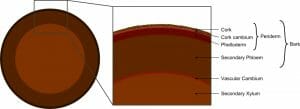What is Tree Bark?
Bark, often “tree bark” in botany, means the outer covering of woody plants. Woody plants, unlike herbaceous plants, create an intricate framework of cells and fibers, which provides significant support and protection. Bark is the woody exterior of this structure. Technically speaking, bark is not necessarily a scientific term. Bark is considered an accumulation of several different outer layers of a wood plant. It consists of tissues outside the vascular cambium, or central bundle of vascular cells. These tissues, unlike bark, are fully alive and transfer fluids from the roots to the leaves.
Function of Tree Bark
Bark, which includes everything towards the outside of the plant starting at the vascular cambium, is much thicker than most people assume. The inner bark is composed of living tissues, which help translocate the sugars created in the leaves to other parts of the plant. This happens in the secondary phloem. Outside of the secondary phloem, cells began to die off, and the layers begin to compress. These layers are responsible for providing protection. The outermost layer, the periderm, consists of several layers of more compressed cells. Some of these are cork cells, which are covered in a special type of wax and don’t collapse when they die.
Trees use their outer bark for different purposes, but mainly for protection against water loss and predators. Insects and herbivores want to eat the leaves off woody plants. These plants are often protected by thick bark past where local herbivores can reach. The outer bark, which the compressed cork layers, is also waterproof. This helps keep the inner bark from drying out, and insures the plant can continue to move sugars from the leaves to where they are needed.
Structure of Tree Bark
As woody plants grow, they grow by adding cells to the internal layers. As the layers are pushed outward, they compress and the cells die. Bark forms as part of this process, and is sometimes considered the entire outside of the vascular cambium. The vascular cambium is the main growth layer in woody plants. As it adds layers to the inside ring of the vascular cambium, the outside is pushed outward. The cells die off, and the fibrous matrix of cellulose and lignin molecules remain. This hard structure forms the bark, and protects the tree or plant from many forms of damage.
While bark is sometimes recognized as all tissues outside vascular cambium, others identify the rhytidome as bark. The rhytidome is only the outermost layer of the plant. If you were to peel back a part of the tree, the rhytidome would come off first. This is what most non-scientists would call bark. However, the cells below this will eventually become bark, and anatomically there is not much of a difference. The rhytidome, however, is completely dead. Scientist have thus termed rhytidome the outer bark, while the secondary phloem and secondary cortex are considered inner bark, because they still have living cells and function in metabolite transport. Remember that all of these layers lay outside of the vascular cambium.
The following image shows only the living tissues in a woody plant, which excludes the outermost rhytidome layer. As seen below, the periderm is also a part of the bark, and has further divisions within which represent distinct layers. These layers provide a barrier against bacteria, insects, and keep the water and nutrients from leaching out of the plant.
Bark is thickest at the trunk of plant. This is not only where plants are the oldest, but also where they can receive the most damage from herbivores, predators of plants. In fact, bark consists of 10-20% of the weight of most woody plants. The bark not only resists damage from animals, but it also prevents desiccation, disease, and provides a resistance to extreme temperatures.
Uses of Tree Bark
There are many commercial uses for bark, and it is often stripped away from the heartwood to be processed. The dead outer bark can be used to make shingles and siding. The outer bark is also known as cork, and can be ground to make cork products like corkboard, cork flooring, and even specialty items like yoga mats. Throughout history, bark has been used to make everything from boats to shingles, as its waterproof nature remains until it disintegrates. Historically, the inner bark has even been used to create flour and make breads out of, though the nutritional capacity pales in comparison to normal cereals.
Some species of plants also accrue peculiar substances in their bark which are good for making spices, sunblock and insect repellent. The inner bark is an important commercial resource for resins, tannins, and even the precursors to products such as latex gloves. In agriculture, there is a technique in which the bark is stripped below ripening fruit. This allows the sugars to remain concentrated in the fruit, and gives a better harvest. This technique is known as girding, and is sometimes used to produce extraordinarily sized fruit. If a branch is girdled, and all but one fruit on that branch is picked, the plant will put all of the sugars and metabolites from the leaves on that branch into the one remaining fruit.
Quiz
1. Which of the following layers is NOT considered bark?
A. Vascular cambium
B. Secondary Phloem
C. Rhytidome
2. Why is it not a good idea to strip all the bark off a tree?
A. The tree will dry out
B. The tree will grow too fast
C. The tree’s fruit will be too sweet
3. Which of the following is a possible use for bark?
A. Water storage container
B. Filter
C. Source of living tree cells
References
- McMahon, M. J., Kofranek, A. M., & Rubatzky, V. E. (2011). Plant Science: Growth, Development, and Utilization of Cultivated Plants (5th ed.). Boston: Prentince Hall.
Tree Bark

No comments:
Post a Comment